


Measuring the crypto market’s strength isn’t as simple as scanning the latest price feeds. Although technical patterns and charting tools help traders analyze market trends, they only give a partial picture of crypto trading sentiment. Even when cryptocurrencies seem to be in an unstoppable rally, sellers suddenly emerge and trigger a steep correction.
On the flip side, cryptocurrencies sometimes unexpectedly bounce out of multiyear downtrends, defying all prior price data and technical patterns. Spotting these swift trend reversals before they happen is difficult, but traders have a few indicators to peek into recent trading activity and guess when sentiment is about to shift.
For example, the relative strength index (RSI) highlights whether crypto assets are overheated or underappreciated. Let’s learn what the RSI is in crypto, its precise predictive powers, and a few precautions when using it to trade virtual currencies.
What is the RSI indicator in trading?
The RSI is a measurement used in technical analysis to evaluate the intensity of recent buying and selling pressure for a cryptocurrency. Mechanical engineer J. Welles Wilder Jr. introduced the RSI in his 1978 book "New Concepts in Technical Trading Systems," and it has since become a standard indicator to measure an asset’s price momentum on short timeframes.
Traders find the RSI beneath a cryptocurrency’s price chart as a line between zero and 100. The values on the RSI chart symbolize the ratio of buying versus selling pressure for a cryptocurrency in a prior timeframe (typically the last two weeks of trading data). The higher the RSI’s value, the more buying pressure there is for a cryptocurrency, and the more likely it’s overbought and due for a price correction. Conversely, when the RSI falls below 30, traders often assume an asset is oversold, and a price rebound is on the horizon.
What is the RSI calculation?
Since the RSI is a popular indicator, traders don’t have to manually crunch numbers whenever they want to determine this value. Crypto exchanges offering RSI readings automatically calculate these values to save users time and energy. However, understanding the basics of manually calculating the RSI helps better understand how this indicator works and what it’s measuring.
Before determining the RSI value, traders need to find a crypto asset’s relative strength (RS) by dividing the average daily price gains by the average losses over a set period. Traders can choose any timeframe, but 14 days is the default in RSI equations. After figuring out the RS, traders plug this value into the following formula:
RSI = 100 - [100/(1+RS)]
Suppose Bitcoin (BTC) closed in positive territory on six days with an average gain of 15% and closed down eight days with an average loss of 6%. To determine the RSI for BTC, traders first divide 15% by 6% to get a value of 2.5, then they plug this number into the RSI calculation:
100 - [100/(1+ 2.5)] = 71.43
Here, the RSI for BTC is high, suggesting it’s in overbought territory.
What are the benefits of RSI in crypto trading?
The RSI gives day traders valuable info on how market participants position their portfolios. Although RSI readings aren’t always reliable when used in isolation, they highlight the latest supply versus demand dynamics and reveal interesting trading opportunities.
Identifies overbought and oversold zones
Revealing when a cryptocurrency is overheated or underrated is the bread and butter of RSI trading. Once traders pull up an RSI feed, it’s easy to see whether buyers or sellers are in control of a crypto asset and develop strategies to respond to the latest market trend.
Spots potential trend reversals
When the RSI and a cryptocurrency’s price don’t move in the same direction, it sometimes gives traders a heads-up on a trend reversal. These early warning signs give traders extra time to position themselves for volatile breakouts or drawdowns.
Highlights price levels for short-term trades
Day and swing traders often use the RSI to set the optimal buy or sell prices and calculate the risk-to-reward for their trade setups. By comparing the current price with oversold or overbought RSI levels, traders better understand whether momentum is on their side when entering the market.
Helps confirm other technical indicators
Using the RSI with other technical analysis tools is beneficial. Comparing the RSI with other indicators like moving averages, the moving average convergence/divergence (MACD), and technical chart patterns helps verify price trends and set up more informed trades.
What are the limitations of RSI trading?
Despite the RSI’s positive traits, it has a few shortcomings crypto traders must consider before applying it. Recognizing the RSI’s potential drawbacks helps traders accurately assess their risk when buying or selling crypto assets.
Variable oversold and overbought levels
When analyzing RSI readings, the standard advice is that scores below 30 signify oversold, and those above 70 are overbought. While these numbers are easy to remember, they’re arbitrary and don’t always play out in the volatile crypto market.
Sometimes, traders must change their expected levels for overbought or oversold territories to fit the current market conditions.
Common false signals
Just because RSI readings are high or low doesn’t mean a reversal is imminent. In many scenarios, crypto prices remain high or low for a long time while the RSI reading keeps screaming overbought or oversold.
Lagging indicator
One reason the RSI sometimes publishes false positives is it relies on prior price data to make future predictions. The time lag in RSI calculations means they don’t register volatile price activity early enough for traders to take full advantage of opportunities.
Unsuitable for long-term strategies
Traders interested in HODLing or dollar-cost averaging (DCA) into cryptocurrencies won’t benefit from RSI readings. Since this oscillator focuses on two weeks of prior trading data, it’s best suited for spotting near-term price movements, unlike long-term price prediction models like the 2-Year MA Multiplier or PlanB’s Stock-to-Flow.
Tips for using the RSI in crypto trading
Even if crypto traders are new to technical analysis, the RSI is one of the simplest indicators to interpret. The lower a cryptocurrency’s RSI falls, the more oversold it is; the higher it climbs, the more likely a crypto is overbought. Although it doesn’t take much practice to use the RSI, traders use a few advanced tactics to customize this oscillator for specific scenarios.
Adjust overbought and oversold thresholds
Usually, an RSI above 70 is overbought, and anything below 30 is oversold (but remember, these values aren’t set in stone). Traders often adjust their preferred RSI score for overbought or oversold conditions in line with the overall market sentiment.
For example, in a pessimistic bear market atmosphere, some traders push both values lower to account for the downward price momentum—and vice versa for bull markets. Although the 70/30 split is popular when interpreting RSI findings, don’t feel limited to these traditional values.
Change time horizons
Similar to the 70/30 model, crypto traders commonly use 14 days when calculating the RSI, but there’s no reason traders can’t plug shorter or longer time frames into their model. Consider changing the time value in the RSI formula for more nuanced information and to better suit a personal trading time horizon.
Test the RSI’s success in paper trading
Paper trading simulators let crypto traders test trading strategies with fake money to get a feel for trading and track their results. Since these trading platforms offer a risk-free environment, they’re ideal for experimenting with technical indicators like the RSI. After getting more familiar with how the RSI works and the best ways to incorporate it into crypto strategies, traders feel more confident about using it in real-world situations.
Use with other technical indicators
The RSI sometimes reveals major price moves or divergences in the crypto market, but it’s not the only indicator available to crypto traders. Consider using RSI readings with other technical and fundamental analytics for more evidence of a cryptocurrency’s price trends and precise info on the optimal entry and exit prices.
See how dYdX perps strengthen crypto portfolios
Eligible crypto traders interested in derivatives trading have all the tools to put their technical strategies into action on dYdX. With deep liquidity, low fees, and up to 20x leverage, there’s no better place in DeFi to swap crypto perpetual contracts than dYdX. Find out how dYdX works and our latest products and services on the official dYdX blog. Also, check out dYdX Academy for more guides and tips on hot crypto trading strategies and technical indicators, and eligible traders can start trading on dYdX today.
Disclosures
The content of this article (the “Article”) is provided for general informational purposes only. Reference to any specific strategy, technique, product, service, or entity does not constitute an endorsement or recommendation by dYdX Trading Inc., or any affiliate, agent, or representative thereof (“dYdX”). Use of strategies, techniques, products or services referenced in this Article may involve material risks, including the risk of financial losses arising from the volatility, operational loss, or nonconsensual liquidation of digital assets. The content of this Article does not constitute, and should not be considered, construed, or relied upon as, financial advice, legal advice, tax advice, investment advice, or advice of any other nature; and the content of this Article is not an offer, solicitation or call to action to make any investment, or purchase any crypto asset, of any kind. dYdX makes no representation, assurance or guarantee as to the accuracy, completeness, timeliness, suitability, or validity of any information in this Article or any third-party website that may be linked to it. You are solely responsible for conducting independent research, performing due diligence, and/or seeking advice from a professional advisor prior to taking any financial, tax, legal, or investment action.
You may only use the dYdX Services in compliance with the dYdX Terms of Use available here, including the geographic restrictions therein.
Any applicable sponsorship in connection with this Article will be disclosed, and any reference to a sponsor in this Article is for disclosure purposes, or informational in nature, and in any event is not a call to action to make an investment, acquire a service or product, or purchase crypto assets. This Article does not offer the purchase or sale of any financial instruments or related services.
By accessing this Article and taking any action in connection with the information contained in this Article, you agree that dYdX is not responsible, directly or indirectly, for any errors, omissions, or delays related to this Article, or any damage, injury, or loss incurred in connection with use of or reliance on the content of this Article, including any specific strategy, technique, product, service, or entity that may be referenced in the Article.







